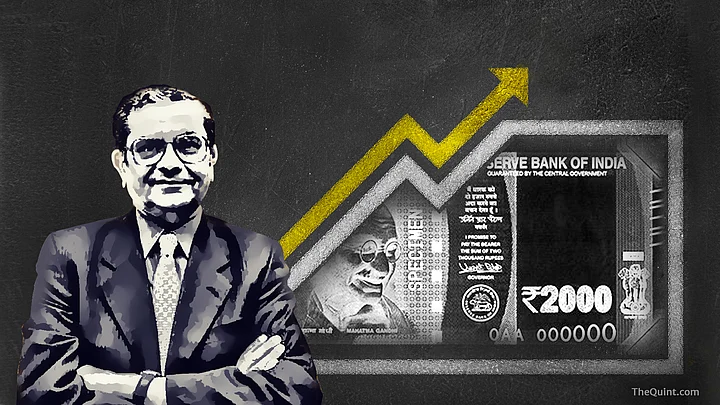In an interview published on 17 March 2017, eminent economist Jagdish Bhagwati, an ardent and unabashed admirer of the current regime, voiced the following opinion:
The Prime Minister’s success in Uttar Pradesh has, therefore, meant that Amartya Sen and his friends who argued that demonetisation would hurt growth have been humiliated and exposed as much as the Congress. On the effects of demonetisation on growth, I should say that I was the one economist who had argued (with my co-authors), from first principles, that demonetisation would increase, not diminish, growth. And that is exactly what appears to have happened.Jagdish Bhagwati in an interview, 17 March
Bhagwati’s eminence is such that his statements might be taken seriously by non-economists, and thus seriously influence their thinking about the effects of demonetisation. I would humbly like to point out that Bhagwati’s assertion is based on what has come to be known in the Trump era as ‘alternative facts’ – portrayals of the current state of the world that deviate significantly from reality.
Myth About Economic Growth
In 2015-16, the Indian economy recorded a growth rate of GDP of 7.9 percent. The most recent official projection of growth for 2016-17 is 7.1 percent. Clearly, a reduction of growth by 0.8 percentage points implies that Bhagwati’s assertions are not supported by statistics published by the very government he seems hell bent on promoting.
As a responsible economist, I have to add that the mentioned decline in growth rate does not point to a negative impact of demonetisation on economic growth as much as it does not support Bhagwati’s assertions pointing to a positive impact. To isolate the impact of demonetisation on economic growth, a much more careful study needs to be done, which effectively controls other changes in the Indian and global economy in 2016-17. As far as I know, no such study has been completed.
But as pointed out in my earlier blog in The Quint, the official projection of GDP growth seems to be plain wrong and amounts to a gross overestimate. Let me explain.
Studies Contradict Post-Demonetisation Gains
Almost all surveys of incomes generated in the informal sector post demonetisation by independent and credible sources show significant negative growth: Prateek Sibal, Paris Institute of Political Studies; Jean Drèze, Delhi School of Economics and University of Ranchi; Vyom Anil, Jawaharlal Nehru University; social activist Harsh Mander; Deepa Krishnan, SP Jain Institute of Management, Mumbai and Stephan Siegel, Michael G. Foster School of Business, University of Washington; and People’s Union for Civil Liberties.
Going by these studies, even a rate of growth of -20 percent for informal incomes for 2016-17 (a severe contraction of such incomes), would seem an optimistic projection.
If we couple this projection with the official projection of 7.1 percent for the entire economy, we arrive at the fantastic and obviously wrong conclusion that formal incomes have grown by a rate in excess of 20 percent. This rate has never been achieved in independent India; in fact, it can be safely asserted that a growth rate of 15 percent has never been reached.
Even if we assume the growth rate for the formal sector in the current year to be the same as that in 2015-16 (imputed to be around 11.5 percent), and the contribution of the informal sector to be around 33 percent of GDP (an extremely conservative assumption, given the last official study on this subject in June 2008), the implied projection for GDP growth in the current year is a measly 1 percent.
Also Read: Modi’s Pied Piper Moment: Note Ban Aimed Only at Drawing Votes
Demonetisation Didn’t Help BJP in UP
Given the facts above, it would be wrong to conclude that the massive victory of the BJP in the recent UP elections was a vote for demonetisation, as Bhagwati has wrongly asserted in his recent interview. Post demonetisation, the party’s propaganda machinery, with the active participation of the PM, went into overdrive highlighting how demonetisation would neutralise the black incomes of the rich.
The man on the street, neglecting his own significant sufferings (imposed by this policy), registered a surge in satisfaction. But this was three months before the first phase of UP elections. Gradually, as the harshness of reality dawned on the aam aadmi class, there was bound to be a tempering of the initial euphoria.
The polarisaton drive of the BJP, as eptomised by the PM’s own ‘shamshan-kabristan’ and ‘Harvard versus hardwork’ remarks, can therefore, be seen as a clever manipulation of flagging euphoria.
Sadly, the entire campaign, based on ‘alternative facts ‘and divisive manipulation of human emotions, has worked wonders. We can only hope for a better future.
(The author is a Professor and Coordinator at the Department of Economics, Centre for Advanced Studies, Jadavpur University. This is a personal blog and the views expressed above are the author’s own. The Quint neither endorses nor is responsible for the same.)
Also Read: Under Fire From Modi, Intellectuals Need to Reach Out to People
(At The Quint, we question everything. Play an active role in shaping our journalism by becoming a member today.)
